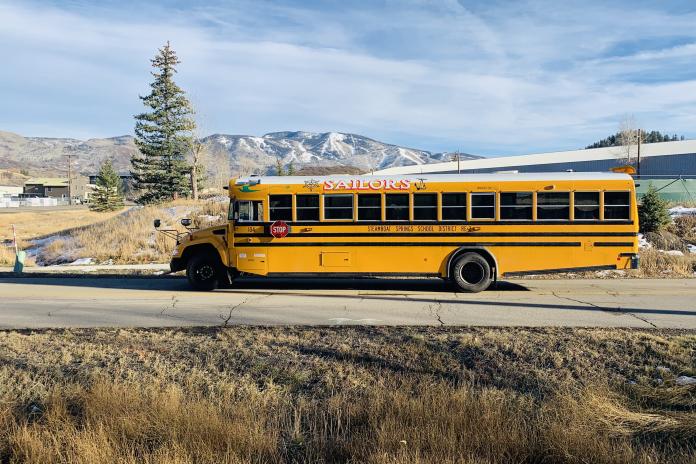How Steamboat Springs Navigates Mountainous Terrain with Electric School Buses
Steamboat Springs School District proves that electric school buses can thrive in all seasons and terrains while delivering cost savings and environmental benefits.

For Steamboat Springs School District in Colorado, which serves a community accustomed to subzero temperatures that can plunge to –20°F, reliable school bus operations are crucial. This district has demonstrated that a fleet of seven electric school buses can successfully serve students in snowy vistas, harsh winters and mountainous terrains.
Steamboat Springs School District began its school bus electrification journey over three years ago with a single electric school bus and expanded its fleet by adding six more buses in the past year, with plans to add three more.

The transition was made possible by state and federal grants, which covered the cost differential that might have slowed adoption. This allowed the district to prioritize children’s health and reliability while meeting the unique transportation needs of the rural community.
Why Steamboat Springs chose electric school buses
For Steamboat Springs, the transition to electric school buses (ESBs) was driven by a combined strategic vision for practical financial opportunities and sustainability. The district was equally motivated by economic and environmental factors, notes Casey Ungs, the district’s director of transportation. According to Ungs, ESBs “aligned with what our district strategic plan has in it about being environmentally conscious and working for sustainability purposes.” Ultimately, the opportunity to secure funding through both Colorado’s Electric School Bus Grant Program and the federal Clean School Bus Program (CBSP) was a game-changer. Steamboat received about two-thirds of its funding from Colorado’s funding program and one-third from the CSBP, allowing the district to “incur close to no out-of-pocket costs for the vehicles and the chargers.”
| Steamboat Springs School District | |
| Location | Steamboat Springs, Colorado |
| Number of students | 2,600 Students |
| Number of schools | 6 Schools |
| Percentage of students who ride the bus | 25% |
| Fleet size | 22 Type C/D Buses; 2 Type A |
| Number of electric school buses in fleet | 7 electric school buses |
Additionally, the district was drawn to the safety and lower total cost of ownership benefits of ESBs. The enhanced comfort and safety of electric school buses further solidified the appeal and ensured a quieter experience for students. The transition also allowed the district to reduce off-site diesel fueling, simplifying logistics and contributing to a lower total cost of ownership.
Ungs has heard from the community on the impact of their electric school buses. He says, “I’ve gotten a lot of [positive] feedback from the community members, for example, a community member sent me an e-mail saying, ‘Hey, I was riding my bike, I passed one of your electric buses. It was amazing, you know versus having a diesel bus drive by and dump fumes on me.’”
Finally, when asked about the mountainous terrain of Colorado impacting performance, Ungs says, “The geography didn’t really impact any decision making by nature of our daily routes.” Ungs notes, “You get regenerative braking that not only helps braking by slowing the vehicle but also adds a small bit of range back to the bus. I’m very satisfied with the range ultimately based on what was stated and what we are getting out of them.”
“I’ve got a lot of feedback from the community members saying, 'It was amazing versus having a diesel bus drive by and dump fumes on me.'" - Casey Ungs, Steamboat Springs School District Transportation Manager
Partners and progress
Steamboat Springs stressed the importance of close collaboration with its utility, Yampa Valley Electric, during the transition to electric school buses. The partnership was crucial for upgrading the district’s infrastructure to support ESB charging, including the installation of new transformers and resolving challenges with switchgears. The district credits this strong relationship for the smooth integration of their fleet, noting that Yampa Valley has been highly responsive to any issues that arise.
Today, the district has seven electric buses fully operational on daily routes, with three more buses slated to join the fleet soon. The range of their ESBs — approximately 100 to 110 miles per charge — is well-suited for most daily routes. In fact, the longest ESB routes are 50 miles, and the buses have performed reliably and rarely need to be charged between morning and afternoon routes when the temperature is favorable. The district currently uses propane buses for routes that exceed that range, however, the aim is to transition these routes to ESBs as infrastructure for longer trips becomes more reliable.
Advice to other districts
Steamboat Springs’ journey offers valuable lessons for other districts considering a similar transition. While the district has encountered some challenges, the responsiveness and support of Yampa Valley Electric has been instrumental in a smooth transition, highlighting the importance of building strong relationships with local utilities during an ESB rollout.
Additionally, Ungs recommends that other school districts look to state-level funding to find more financial opportunities that are more in tune with what school districts in the state need. With these specific funding sources, he says, “It’s something to be celebrated, especially because it allows rural districts to go out on that limb with ESBs,” knowing that local conditions are considered in the funding model.
With the right relationships and careful planning, the transition to ESBs can be a rewarding step toward sustainability and cost savings.